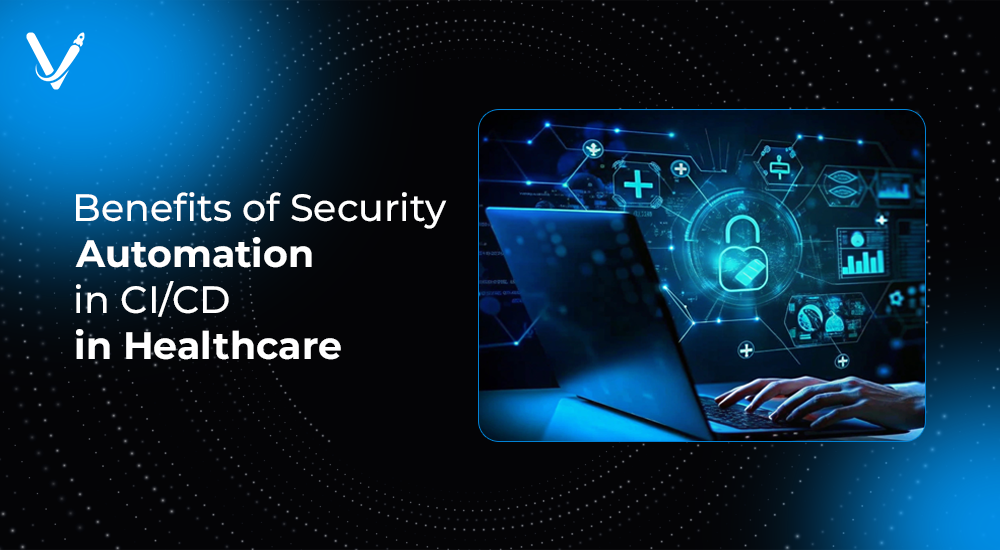Benefits of Security Automation in CI/CD in Healthcare


- Apr 25, 2025



The healthcare industry is undergoing a rapid digital transformation. From electronic health records (EHRs) and telemedicine platforms to AI-driven diagnostics and patient engagement apps, software is at the heart of modern healthcare delivery. To keep pace with innovation and deliver value quickly, many healthcare organizations are adopting Continuous Integration and Continuous Delivery/Deployment (CI/CD) practices.
However, speed cannot come at the expense of security, especially in an industry governed by strict regulations like HIPAA and handling incredibly sensitive Protected Health Information (PHI). This is where Security Automation within the CI/CD pipeline becomes not just beneficial, but essential.
In essence, security automation is not just a defensive strategy—it’s an enabler of innovation. By weaving security into the CI/CD fabric, healthcare providers can deliver cutting-edge applications that are both fast and trustworthy.
In the following sections, we’ll explore the core principles of CI/CD, why security automation is a must in healthcare, real-world success stories, and a practical roadmap to implementing secure CI/CD pipelines.
CI/CD stands for Continuous Integration and Continuous Deployment (or Delivery). It’s a cornerstone of modern DevOps practices and refers to the process of automating the integration, testing, and delivery of code changes.
What is CI/CD in practice? It’s about releasing high-quality code at speed while maintaining reliability—a necessity for healthcare software development that demands both agility and safety.
With data breaches in healthcare averaging $10 million in damages per incident (IBM 2023), security cannot be optional. Every code change that enters production must be secure by design.
CI/CD security automation ensures these risks are mitigated early and continuously.
Security automation in CI/CD refers to the practice of embedding security processes, tools, and checks directly into the continuous integration and continuous deployment pipeline. Instead of treating security as a separate phase that happens at the end of the software development lifecycle, security automation integrates it from the beginning—often described as “shifting security left.
This approach ensures that every piece of code, every configuration, and every dependency is examined for vulnerabilities as it moves through the pipeline. Whether it's scanning for hardcoded secrets, identifying misconfigured infrastructure, or flagging risky open-source components, security automation allows development teams to detect and resolve issues early—often in real-time.
It reduces the risk of breaches, minimizes the cost of remediation, and enables developers to deliver secure code at speed. By treating security as code and making it a continuous, automated process, healthcare software development teams can align faster innovation with compliance and patient safety.
Security automation in CI/CD offers a transformative edge in healthcare software development, where safeguarding sensitive data and ensuring compliance are paramount. By embedding security into the pipeline, teams benefit from continuous monitoring, early threat detection, and scalable defenses. Here's a closer look at the most impactful benefits:
One of the most significant advantages of security automation is its ability to identify vulnerabilities early in the development lifecycle. Traditional security checks often occur late, making them more costly and time-consuming to fix. Automated tools like Static Application Security Testing (SAST) scan code as it's written, alerting developers to flaws before they reach production. This not only reduces technical debt but also enhances software reliability.
Example: A telehealth startup that integrated automated SAST into their GitHub CI workflows reduced post-release vulnerabilities by 70%. This proactive approach allowed them to resolve issues swiftly and maintain patient trust.
In the healthcare sector, compliance isn't a one-time checkbox—it's an ongoing requirement. Security automation supports continuous compliance by integrating regulatory checks directly into CI/CD pipelines. This ensures that every code change is validated against standards such as HIPAA and HITRUST.
Automation tools continuously track potential violations, generate real-time logs, and create comprehensive audit trails. This not only streamlines internal reviews but also prepares teams for external audits without the last-minute scramble.
Security should never be a bottleneck. When implemented correctly, security automation runs alongside your existing CI/CD workflows, enabling faster and safer deployments. Automated scans occur in real time, and issues are flagged without halting the pipeline unnecessarily.
This approach supports deployment strategies like canary releases and blue-green deployments, allowing teams to test in production environments with confidence and rollback capabilities if needed. The result is an agile release process where innovation doesn’t come at the cost of security.
Security often carries a stigma of slowing down development. Automation flips that narrative by giving developers the tools they need to code securely from the start. With real-time feedback and clear, actionable insights, developers can fix issues on the spot.
Integrated development environments (IDEs) can be configured to surface vulnerabilities as code is written. This reduces context switching, promotes secure coding habits, and ultimately results in higher-quality software.
Manual security checks are prone to inconsistencies, especially across multiple teams and environments. Security automation standardizes enforcement by applying the same checks and policies across all stages of the CI/CD pipeline.
Using policy-as-code frameworks, security rules are version-controlled and automatically applied, ensuring that every branch, microservice, and deployment meets the same standards. This consistency minimizes human error and builds trust in the development process.
As healthcare systems become more complex, security must scale to match. Security automation is designed to adapt, whether you're managing a simple web app or a large, distributed EHR platform.
Automated tools integrate seamlessly with cloud-native architectures, container orchestration platforms like Kubernetes, and hybrid environments. They evolve alongside your infrastructure, ensuring your security posture is always aligned with your technical growth.
By leveraging these benefits, healthcare organizations can develop and deploy software that is not only innovative but also robust, secure, and compliant with the industry's highest standards.
A hospital network implemented GitLab CI/CD with SCA, SAST, and IaC scanning to secure their EHR migration to AWS.
An mHealth app used DAST and secret scanning to prevent credential leaks.
Successfully implementing security automation in a CI/CD pipeline requires a strategic approach that integrates people, processes, and technology. Below is a comprehensive breakdown of the steps you can follow to adopt security automation tailored to healthcare software development.
Begin by conducting a thorough audit of your current development and deployment processes. Identify where security practices are currently implemented and where vulnerabilities may exist. Key aspects to review include:
Selecting the right tools is critical. Look for automation testing tools that are compatible with your CI/CD stack and meet healthcare-specific compliance needs. Recommended categories and tools include:
Once you've selected tools, integrate them directly into your CI/CD pipeline. Here’s how:
To standardize enforcement, convert your organization’s security requirements into code. Policy-as-code ensures consistent security validation across all environments and allows for easy version control and audits.
Even the best automation tools are ineffective without developer buy-in. Offer ongoing training to help developers understand:
Security automation isn’t a one-and-done task. Continually monitor your pipelines and gather metrics to assess effectiveness:
In the high-stakes world of healthcare software development, there is no room for security compromises. Automation in CI/CD pipelines allows organizations to scale development without sacrificing compliance, security, or speed.
Whether you’re managing a sprawling EHR platform or building the next telehealth breakthrough, CI/CD security automation empowers your team to innovate safely and efficiently.
At Vasundhara Infotech, we help healthcare companies build resilient, secure, and future-ready software with seamless CI/CD integration. Our healthcare software development services include tailored CI/CD pipelines, automated testing, compliance monitoring, and DevSecOps enablement.
Let’s build safer healthcare software, faster. Contact us today to begin your security automation journey.
Copyright © 2025 Vasundhara Infotech. All Rights Reserved.